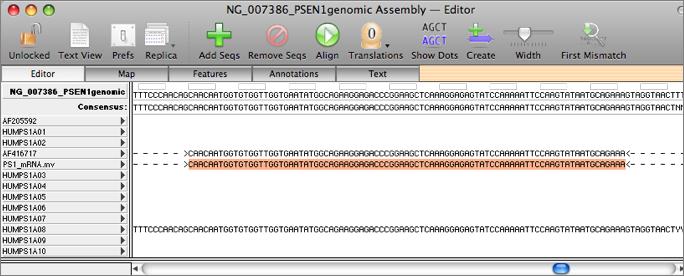
- #MACVECTOR ALIGNING ILLUMINA READS TO A REFERENCE SEQUENCE HOW TO#
- #MACVECTOR ALIGNING ILLUMINA READS TO A REFERENCE SEQUENCE FULL#
The mitochondrial genome (mitogenome) also varies greatly in size across species belonging to the same family, such as in Cucurbitaceae, where the mtDNA of Citrullus lanatus is 379 kb, while in Cucumis melo it is 2740 kb in size. It is larger and highly variable in size, ranging between 208 kb in Brassica hirta and 11.3 Mb in Silene conica. In higher plants, the mitochondrial DNA (mtDNA) displays unique features when compared with animal and fungi counterparts. Mitochondrion is a semi-autonomous organelle that supplies cells with ATP through oxidative phosphorylation. These included co-transcription of genes with open reading frames that are probably expressed, methylation of an rRNA at a position that should impact translation efficiency and extensive RNA editing, with a high proportion of partial editing implying frequent mis-targeting by the editing machinery.

The RNA-seq data revealed peculiarities in transcriptional and post-transcriptional processing of mRNAs. Inter-cultivar variability was null, while comparative analyses with other species of the Solanaceae family allowed the investigation of the evolutionary history of their mitogenomes. We found that the potato mitogenome has a multi-partite architecture, divided in at least three independent molecules that according to our data should behave as autonomous chromosomes. tuberosum cultivars, namely Cicero and Désirée, and a comprehensive study of its expression, based on high-coverage RNA sequencing data.

Based on the relevance of the potato crop worldwide, herewith we report the complete mtDNA sequence of two S. For most plants, the mitochondrial DNA (mtDNA) can be represented as a single circular chromosome, the so-called master molecule, which includes repeated sequences that recombine frequently, generating sub-genomic molecules in various proportions. They are larger and more complex than in other eukaryotes, due to their recombinogenic nature. But any set of Smith-Waterman scoring parameters represents an imprecise model of genomic mutation and sequencing errors, and differently tuned alignment scoring values can be more appropriate for some applications.įor more information, see the Illumina DRAGEN Bio-IT Platform v3.5 User Guide (document # 1000000111887).Mitochondrial genomes (mitogenomes) in higher plants can induce cytoplasmic male sterility and be somehow involved in nuclear-cytoplasmic interactions affecting plant growth and agronomic performance. The default DRAGEN scoring values are reasonable for aligning moderate length reads to a whole human reference genome for variant calling applications.
#MACVECTOR ALIGNING ILLUMINA READS TO A REFERENCE SEQUENCE HOW TO#
The specific values chosen for scores in this algorithm indicate how to balance, for an alignment with multiple possible interpretations, the possibility of an indel as opposed to one or more SNPs, or the preference for an alignment without clipping. The overall highest scoring path through the matrix is the alignment chosen. A match between read and reference provides a bonus, on the score, and a mismatch or indel imposes a penalty. For each of these candidate alignment positions, Smith-Waterman generates scores that are used to evaluate whether the best alignment passing through that matrix cell reaches it by a nucleotide match or mismatch (diagonal movement), a deletion (horizontal movement), or an insertion (vertical movement). These comparisons correspond to a matrix of potential alignments between read and reference. This well-documented algorithm works by comparing each position of the read against all the candidate positions of the reference.
#MACVECTOR ALIGNING ILLUMINA READS TO A REFERENCE SEQUENCE FULL#
These results are then refined by running full Smith-Waterman alignments on the locations with the highest density of seed matches. The first stage of mapping is to generate seeds from the read and look for exact matches in the reference genome.


 0 kommentar(er)
0 kommentar(er)
